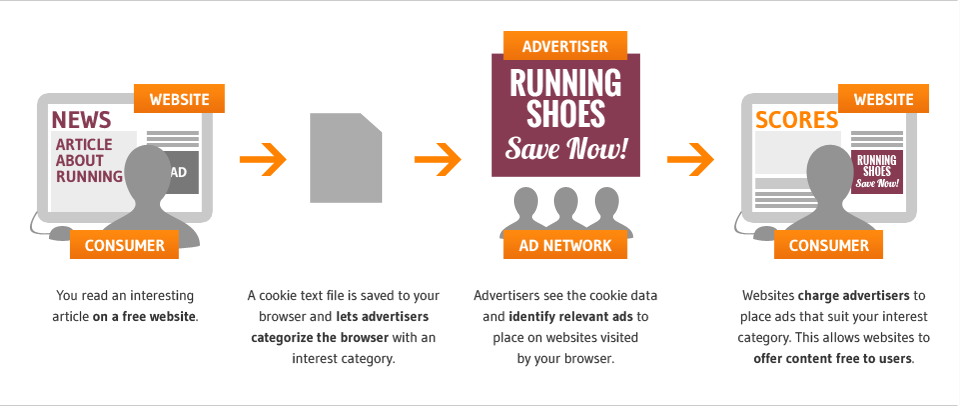How Does It Work?
With Tailored Advertising, NAI member companies help advertisers show relevant ads — matching these ads with broad interest categories or groups like “male clothing shoppers 25-34” or “car buyers in Illinois.”
NAI members distinguish between visitors to a site and users of an app, assigning them to broad interest category groups using information such as the types of websites visited or the demographics of people who use a certain app. For NAI members, Tailored Advertising is not about you as an identified individual. Instead, NAI member companies make educated guesses about the preferences and interests of consumers like you.
HOW DO I GET PLACED IN INTEREST CATEGORIES AND GROUPS?
The basic way you are placed into an interest category or group on a browser is based on your visits to websites. Let’s say an NAI member company partnered with a clothing retail website that you visit. That NAI member would assign an ID to your browser usually by storing a unique ID number in a text file or cookie on your browser. This is then matched to a “clothing shopper” category by pairing that ID number with interest categories/groups in an online database.
| Unique ID Number | Matched Categories |
| 450982374 | “Male”,”Age 25-34″,”clothing” |
Other information can be used to match you into a group, as well. For example, if you have previously purchased oxford shirts from that retail website, the website could tell the NAI company to also match “oxford shirt buyer” to the ID.
On mobile apps, the process is similar but it uses a different set of technologies. The mobile operating system you use, like Android or iOS, is likely to provide an identifier specifically for advertisers to use. This Mobile Advertising Identifier functions similarly to a cookie. It enables advertisers to identify your behavior across apps, without needing to use a more permanent phone or tablet identifier. Most of these identifiers include privacy options that allow users to reset the assigned identifier or to opt-out of Cross-App Advertising.
To do Cross-App Advertising, the NAI member may work with an app so that it can send them information relevant to your preferences. For example, if you open an app to look for highly rated local seafood restaurants, that app may tell the NAI member that a user with your device identifier may be interested in seafood, and that the user is in downtown Manhattan. This information may be used to show ads for more local seafood places.
| Mobile Device Identifier | Matched Categories |
| AEBE52E7-03EE-455A-B3C4-E57283966239 | “Male”,”Age 25-34″,”seafood”,”downtown Manhattan” |
HOW DO ADS KNOW WHERE I AM?
Do you ever see an ad that’s specific to the city you are in? NAI members may sometimes use your location to make sure they don’t serve ads for snow shovels in Florida or for Boston Red Sox tickets in New York.
So how do advertisers customize ads based on your city or region? Historically, they used numbers called IP addresses, which are assigned to computers or devices on the Internet. You may have seen them before; they look like this: 198.101.218.235. An IP address is how computers and devices are able to identify each other and know where to send information over the Internet.
IP addresses can be associated with general geographic areas and that is how NAI members sometimes use this information to show ads customized to your region.
Browsers and mobile devices now also include numerous technologies to identify your location, including GPS (Global Positioning System), Wi-Fi triangulation, and iBeacons. These types of location tend to be more precise than location derived from IP Addresses. NAI members are required to obtain Opt-In Consent from you if they want to collect your precise location for Tailored Advertising purposes.
HOW DO ADS KNOW WHAT I AM SHOPPING FOR?
Is there a pair of shoes popping up as you surf the Internet? A piece of furniture you’re seeing advertised on several different websites you’ve been reading? How does this happen? The process is essentially the same as getting placed in any interest category, as described above. Except, instead of a broad interest category, it is an interest in a specific product like “Brown Pants” or “Green Dress.” We call this Retargeting, and all of NAI’s requirements for Tailored Advertising also apply to this practice.
Let’s say you shop for a pair of shoes. The website where you shopped can tell the NAI member it works with to assign a pseudonymous ID and associate that ID with that particular brand and style of shoes. Now, that retailer will know to advertise the exact pair of shoes to you. This process does not require retailers to know anything about you as an individual, only that someone using your browser showed interest in their products. Advertisers place bids to reach thousands or millions of people that are interested in shoes.
HOW DO ADS KNOW WHAT I AM WATCHING ON MY TV?
Many TV streaming devices and smart TVs include unique advertising identifiers and have the ability to collect data about the content viewed by users, as well as the user’s interaction with some applications available on these devices, for digital advertising purposes. “Viewed Content Data” refers to videos, titles, programs, etc. that you watch on a television. The operating systems on many of these devices include built-in settings to help users’ express privacy preferences for digital advertising data collection and use. To learn more about user choice mechanisms on various connected devices, please see about internet connected tv choices.
WHY DO I SEE ADS RELEVANT TO A BRICK AND MORTAR STORE I VISITED OR SOMETHING I BOUGHT ON A RETAILER’S WEBSITE?
When offline customer information is connected with online users by matching Personally Identified Information (PII) gathered from offline datasets to find the same customers online, it is called onboarding. In the hands of advertising technology companies, this practice does not typically include data that directly identifies an individual. Rather the offline PII is encrypted or hashed and then matched between an advertiser’s customer database and an online advertising identifier, and only information or inferences regarding a user’s interests or demographic information is linked to the identifier, such as a cookie ID or mobile advertising ID. When this information is used for online advertising, it is called Audience Matched Advertising (AMA)..
OTHER THINGS TO KNOW:
Who are the players in Tailored Advertising?
You:
The consumer
Publisher:
The individual or business in charge of a website or app. They sell advertising space on their websites and apps to advertisers.
Advertiser:
The individual or business that has a product or service they want to advertise. They buy advertising space on websites and apps.
Third-Party Advertising Company:
Websites and apps usually do not play a direct role in choosing the ads you see. Instead, a third-party advertising technology company manages the ad selection and placement for both the publisher and advertiser. It makes the process more efficient for everyone.
NAI members are companies who are committed to empowering individuals to make informed decisions about their advertising choices. NAI members include advertising networks and other third-party online companies who help create, deliver, and manage the ads you see. These companies are all committed to responsible practices. Read more about our members.

Many of the banner ads displayed on web pages are not selected and delivered by the websites you visit, but by network advertising companies that manage and provide advertising for numerous unrelated websites. These companies, which we refer to as “third-party ad networks,” or “third-party ad companies,” join the NAI to signal their commitment to privacy best practices and in some occasions to provide a means for consumers to opt out of Targeted Advertising on the NAI website.
The term “third-party” indicates that rather than having a direct relationship with a user, a company has a relationship with one or more of the websites that a user visits. For example, if a user visits sportsfan.com, that website is the “first party.” If sportsfan.com partners with an advertising network, platform, or exchange to place ads, the network, platform, or exchange is the “third party.” The advertising network uses cookies when the user visits sportsfan.com to help it select and serve the best ad. These cookies are considered “third-party cookies.” First parties partner with third parties in this way because third parties have technology and expertise to enable more efficient ad placement across websites. NAI members, working with brands, publishers and websites, use third-party cookies to make advertising more engaging and relevant to users and more valuable to publishers and advertisers.
An example of a non-cookie technology is a statistical (or probabilistic) identifier. Such an identifier is the result of a computation about a browser or device that companies rely on to tailor their online advertising. Instead of placing a cookie on a browser, and then reusing the value inside of the cookie to identify the browser, companies hope to identify a browser or device by using data about the browser or device to compute a value. Non-cookie technologies operate differently and could be used for a variety of purposes. These could include ensuring your online banking stays secure, preventing online shopping fraud, or serving you the right online advertisements.
Most modern mobile devices (iOS 6, Android 2.3, and Windows 10 and above) provide mobile advertising identifiers. These are randomly-generated numbers that are associated with your device that often come with options to reset the identifier and opt-out of Cross-App Advertising. These identifiers have different names depending on the operating system. For example, they are called Google Advertising ID (GAID) on Android devices whereas on iOS, they are called Identifiers for Advertisers (IDFA). They are included to provide advertisers a method to identify your devices without using a permanent device identifier, like your phone’s serial number.
Many of the banner ads displayed on web pages and applications are not selected and delivered by the websites or apps you visit, but by third-party advertising companies that manage and provide advertising for numerous unrelated websites and applications. Websites and applications work with third-party advertising companies because these companies can more efficiently sell advertising space. This enables websites and applications to make more revenue and continue providing free content and services. Some of these companies, which we refer to as “third-party ad companies,” join NAI to signal their commitment to privacy best practices and in some occasions to provide a means for consumers to opt out of Tailored Advertising on the NAI website or via mobile platform settings or smart TV and streaming device settings.
The short answer – a Web beacon enables two websites to share information. Generally, a web beacon consists of a small piece of software code, just like the other code that makes up a web page, that incorporates a graphic image on a web page or email. There may or may not be a visible graphic image associated with the web beacon, and often the image is designed to blend into the background of a web page or email. Web beacons can be used for many purposes — including site traffic reporting, unique visitor counts, advertising auditing and reporting, and personalization.





